|
|
|
snorkeling with a sea turtle
Thursday, January 27 2005
setting: Floreana Island, Galapagos, Ecuador
I'd been feeling not entirely well for the last couple of days. At first I blamed my condition on my unfamiliarity with the rough ocean. Then I blamed the intensity of the tropical sun, against which even SPF-30 sunblock can only do so much (especially when applied in a hurry). But then after I'd swallowed a little too much saltwater and my eustation tubes seemed to jam, I blamed my inexperience with snorkeling. This morning, though, I could tell I had a more fundamental health problem. Sometime during the night I'd developed a sore throat. I took this to be an ominous sign, since I almost never get a sore throat unless I'm coming down with a cold. But what could I do about it except try to maximize my fruit intake? There weren't any Vitamin C tablets on the Golondrina, and the stuff given to us under the rubric "jugo" (juice) was actually some sort of chemical cocktail padded with sugar water.
During the night the Golondrina headed west to the island of Floreana, the longest-settled island in the Galapagos. As we zeroed in our our ultimate destination, Punta Cormorant, we passed the rugged remains on an ancient volcano core sticking out of the ocean. This was Devil's Crown, purportedly one of the best snorkeling sites in the Galapagos. As for Punta Cormorant, it amounts to an intact volcano cone attached to Floreana via an expanse of sandy flatlands. The name is something of a mystery, since it's never been home to cormorants, though there are a few endemic flightless cormorants on other islands.
Our panga dropped us off on the beach to the west of Punta Cormorant, where our guide Cezar drew our attention to the unusually dark brown beach sand. It turned out to be rich in tiny green crystals of olivine, evidently a large component of the local lava. While Blue Footed Boobies dove dramatically for fish, several Galapagos penguins periodically materialized above the waves.
Cezar led us inland past a large saltwater lagoon unexpectedly rich in pink flamingos, the same species that lives in Florida (though I've never been there). We crossed a low divide and descended to the beach on the east side of Punta Cormorant. Interestingly, there were no sea lions to be seen on this beach. The few marine iguanas and Sally Lightfoot crabs present kept to an exposed wall of lava at the edge of the beach. But out in the surf we could see several large sea turtles swimming about, carrying on with their sea turtle business. With them were a few penguins.
But the biggest attraction was the sting rays. A group of us stood around a few yards from the shoreline and nervously waited, not moving. Sometimes a retreating wave would reveal an ominous sight: six or seven sting rays half-hidden in the sand. They're dangerous animals, but if you leave them alone and don't step on them, they're content to observe the golden rule. Occasionally someone would squeal with a mixture of horror and delight as a sting ray would brush against his or her foot.
I wondered about the absence of sea lions until a green-eyed biting fly, somewhat smaller than a horsefly, tried to suck my blood. It was a painful experience, and I imagine it would be so for a sea lion as well. I'm guessing that horseflies depend on stagnant water for one of the stages of their life cycle, and such water isn't present on, say, Española, making it a preferred sunning location for sea lions.
Later on we all went snorkeling at the rocky ruins of Devil's Crown, but the currents were so strong that I didn't dare jump in until the very end, when we were in the middle of the crown and sheltered from the ocean's strongest forces. Meanwhile, the others were seeing all sorts of fun creatures in the clear saltwater, including sharks and octopi.
During lunch and the subsequent siesta, our boat sailed further west along the Floreana coast to a place called Post Office Bay, where a makeshift postal system was set up by seafarers well over a hundred years ago. People wishing to send mail to other parts of the world would leave their items in a weather-tight container for others to pick up and take with them if they happened to be headed in the right direction. This system remains intact to this day, but now of course it's more of a tourist activity than anything else. After a panga ride around the lava boulder fields, we had a wet landing on the beach at Post Office Bay and climbed up to a manmade lookout above a solar-powered lighthouse.
During a later panga ride past mangrove thickets, we saw several adolescent sea lions hassling a marine iguana who was doing what he could to maintain what remained of his scaly reptilian dignity. In the world of the Galapagos, there's no greater distance on the comic-straightman continuum than the one between sea lions and marine iguanas.
Eventually we landed on Floreana and walked the short distance to the "post office." Up until this point, the entirety of our Galapagos adventure had been about the natural world. But the post office is a human artifact and has nothing whatsoever to do with finches, boobies, sea lions, iguanas, or Darwin's discovery of evolutionary forces. It's a crude jumble of wood and fragile little signs written in various languages. Somewhere within it is an envelope with all the post cards that visitors have left for others to take home and mail. The idea is that you leave some post cards for future visitors to mail and in exchange you mail a few that have been left behind. It's a complete anachronism in today's world: needlessly inefficient and absolutely dependent on the honor of strangers. But for someone weary of wildlife, the Floreana post office is a welcome retreat back into the realm of the human. Indeed, you could see the pale faces of the Australians in our contingent lighting up. They attacked the envelope of post cards with enthusiasm and immediately began assigning its contents to Golondrina's passengers according to country of destination. As you might imagine, the bulk of the cards were written by and for Americans, and the Australians would have had us take them all had they had their way. But misanthropes that we are, we only took two (both addressed to locations in New York) and announced that we were done with this activity. Since we hadn't prepared any of our own post cards, we were still going above and beyond the call of duty.
We wandered uphill to the scattered remains of an old iron ship that somehow had come to rest at least fifty feet above high tide. After the others had finally exhausted the possibilities of the post office, our guide Cezar led us further uphill to the mouth of an old lava tube. Lava tubes are cavelike structures formed when a flow of molten lava cools from the outside, creating a hard skin out of which the lava eventually drains. This particular tube went at least a quarter of a mile underground. Someone had built a series of ladders and steps allowing people to descend the steep part near the claustrophobic entrance. Further in, the space opened up and the slope became gentle. Before long the floor fell beneath the water table, reminding me of the River Styx from Greek mythology. For some reason Cezar insisted on leading people beyond this point, though Gretchen and I hung back at the subterranean water's edge with nothing but the weak-to-nonexistent light of our borrowed flashlights. Eventually, though, the water was too deep and the others were forced to turn back.
We returned to the beach with the idea of swimming and perhaps snorkeling, but there'd been some confusion about whether or not to bring our snorkeling gear. Someone told us that the crew from the Golondrina had dropped off some snorkeling gear for anyone who wanted to use it, so a number of us selected random masks and flippers from a pile of such things on the beach. This equipment was unfamiliar and associated with a towell and personal items that suggested it was someone's temporary beach encampment, but we were so eager to snorkle we didn't think about it too much. Once out in the water, we were amazed by how crappy this snorkeling equipment was. But since it was the only equipment available, we just went with it. I was having particular problems because I can barely snorkle to begin with, and since my mask had a slow leak, I was in constant fear of drowning. Despite the strong waves I had to stay near the rocks so I could pull myself into the atmosphere every so often.
Near the beach there was a fair amount of sediment, but a short way always near a pile of black lava rocks, visibility was good and there were things to be seen beneath the waves. Before long a group of Golondrina people had gathered and a circle near the rocks and they could be heard excitedly talking about the presence of a sea turtle whenever their heads came above the surface. So I picked my way over and joined the circle. Sure enough, in about five feet of water, not far from the bottom, was an enormous turtle lazily grazing on vegetation growing on the rocks. He or she didn't seem the least bit concerned about the four or five humans overhead. We floated there for awhile looking at the beast. Periodically a wave would drag me away and I'd have to clamber back. At one point the currents made the turtle come very close to me, or at least that was how it appeared. It was just too tantalizing; I had to know how a sea turtle's flipper felt. So I closed the distance remaining, which was at least six inches, and touched it. It was smooth and rubbery, as I had imagined it would be (but somehow subtly more alive). The turtle didn't seem to notice.
Heading back to shore, one of the Australians was on the beach shouting that I'd taken some other group's snorkeling gear. That seemed to explain everything. It turns out that nearly all of us who had just been observing the sea turtles had raided another tour group's supplies. The authority figures from this other tour group were pacing back and forth on the sand, visibly fretting. Based on their language and appearance, this group looked to be entirely Ecuadorian. How sad that they had to get by with shitty second-hand snorkeling gear in their own country while us foreigners get all the good stuff!
Meanwhile Cezar was having a minor freakout, since this this had been (to date) the first real glitch in the tour. In a clearly exasperated voice he told us that we had to keep track of our gear, that we were just renting it and that we would be charged if any of it turned up missing. Oddly, he didn't address the issue of how another tour might feel having their equipment unceremoniously borrowed, but I had the feeling that Cezar was also concerned that the offended tour guides might report on the doings of the Golondrina back at headquarters in Puerto Ayora. Mind you, this incident hadn't entirely been the fault of those of us who had grabbed the others' snorkeling gear; we'd been told that gear would be provided and it hadn't been.
During the panga ride back to the Golondrina, Gretchen and I were on separate pangas. With Gretchen was the loudest and most annoying of the Australian women, and she started talking about me, saying, "The American boy touched the sea turtle." And then she went on to explain how this is bad, because if everyone touched the turtles eventually they'd lose their tameness and everyone would suffer. She actually had a valid point, but Gretchen was irritated anyway and responded, "Oh you mean my husband?" Then she defended me, saying the turtle had actually veered into me, which (though not entirely true) was what I had told Gretchen.
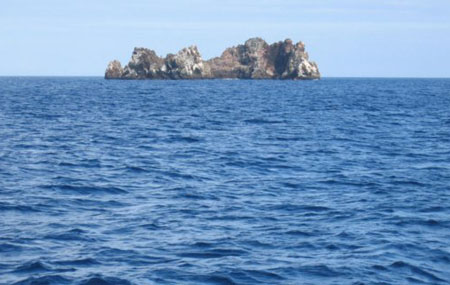
Devil's Crown.
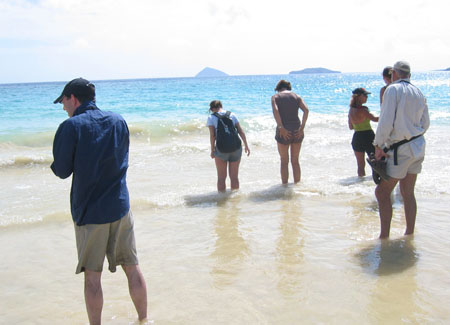
Waiting for the sting rays.
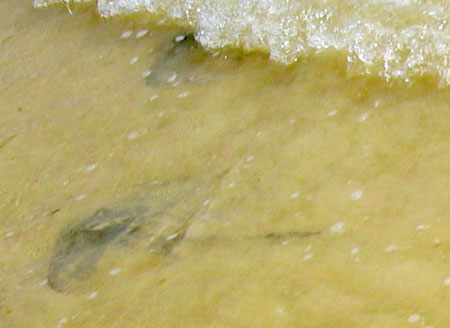
Sting rays in the Floreana surf.
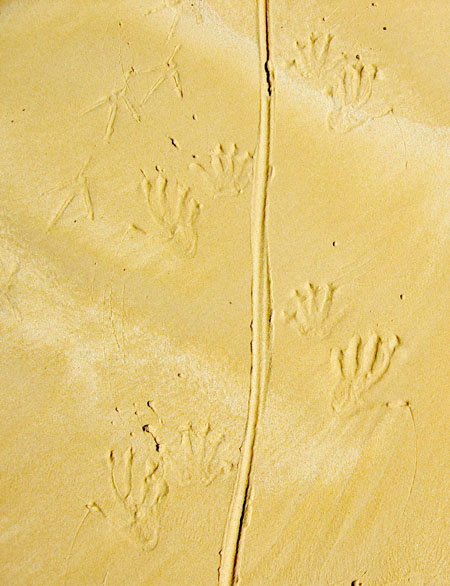
Marine iguana tracks.
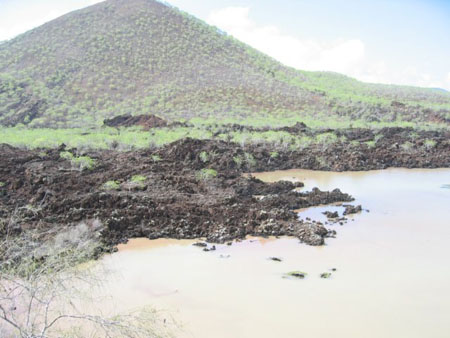
Saltwater lagoon on Floreana.
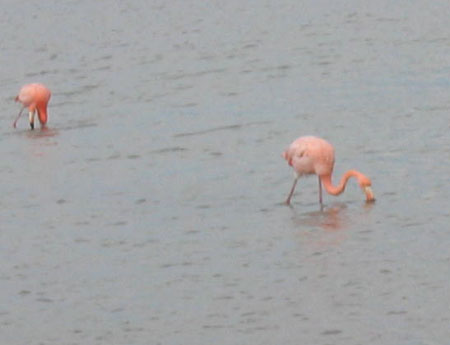
A couple flamingos in the lagoon.
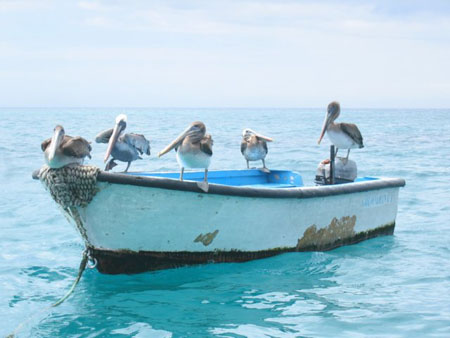
Pelicans on one of the Golondrina's pangas.
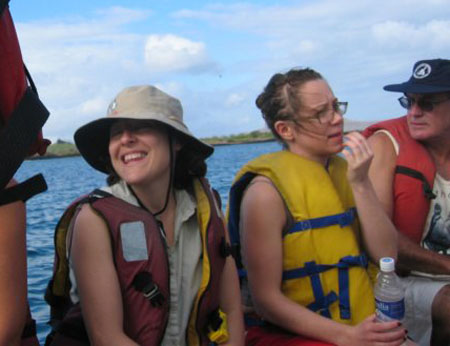
Gretchen and Karin (one of the Swedes) riding on a panga.
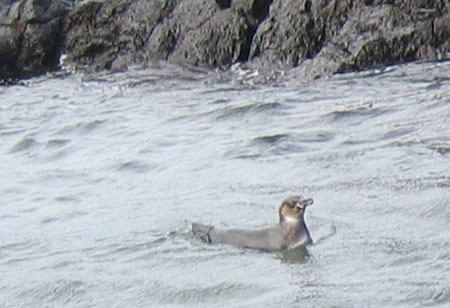
A Galapagos Penguin.
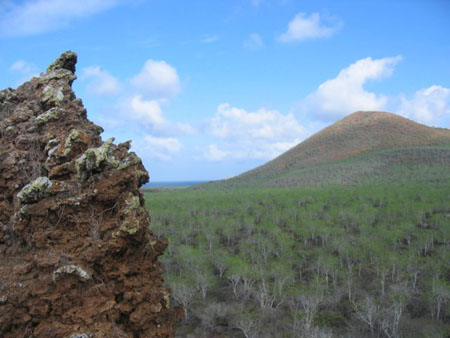
Floreana landscape, viewed from a lookout platform.
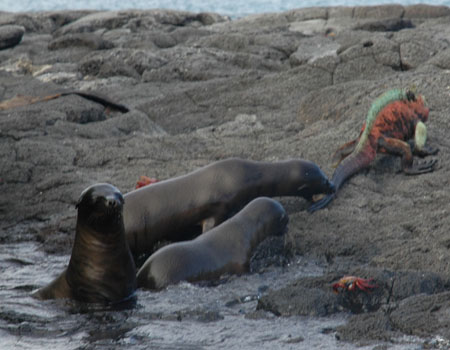
Sea lions pester a colorful marine iguana. (Photo by Karin Tideström.)
For linking purposes this article's URL is:
http://asecular.com/blog.php?050127 feedback
previous | next |










